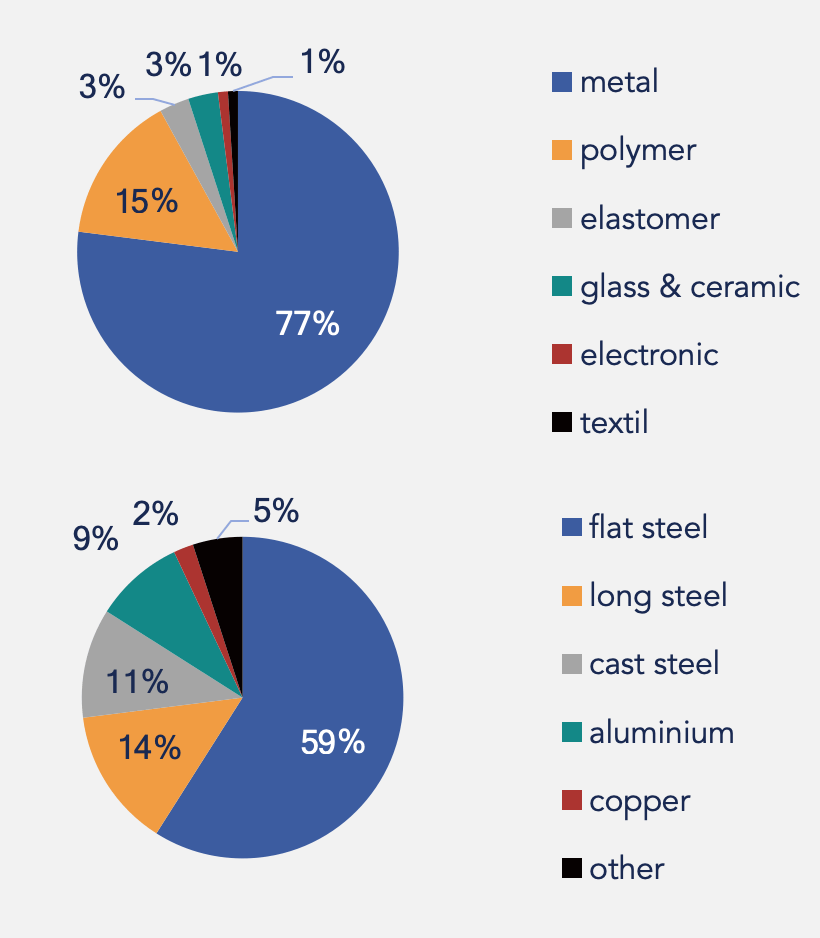The automotive sector is increasingly committed to reducing its environmental footprint, and more specifically its CO2 emissions. The task promises to be complex, as emissions are generated at many levels, from “cradle to grave”. Under what conditions can the choice of materials used to make automobiles have a significant impact on the goal of reducing emissions?
Materials are an effective lever for reducing CO2 emissions by reducing vehicle mass
Source : Presans and ICCT 2014
The choice of materials has a direct impact on the mass of the vehicle, and therefore on its energy consumption and CO2 emissions. The relationship between mass and emission levels has been widely studied and can be easily estimated.
The potential for mass reduction remains significant by using more expensive materials (composites), and/or improved industrial processing (e.g. 3D printing).
However, the choice of materials must take into account the whole life cycle, as well as other constraints such as cost and regulations. It must also take into account functions related to energy management (e.g. power electronics or battery thermal management) and on-board durability (e.g. air conditioning), which may have no visible impact on CO2 emissions as defined by current regulations.
The reduction of CO2 emissions competes with the satisfaction of other constraints
Optimizing CO2 emissions by exploiting the leverage of materials means:
- Reducing the mass;
- Optimizing energy efficiency;
- Taking into account the use and life cycle of vehicles.
For a given functionality/optimization, focus on:
- Cost optimization;
- Regulatory constraints on materials (e.g. REACH, ELV, RoHS, EURO X standards and their worldwide equivalent)
An effective approach for the best choice of material combination should take into account:
- Net effective cost = cost – CO2 benefits1;
- {Product + process} (expected volumes / optimization of industrial processes).
Vehicles contain a wide variety of materials for a variety of uses, and manufacturers have only partial knowledge of their impact in terms of emissions
Vehicles contain a variety of materials for a variety of uses as a result of continuous efforts on the part of the automotive industry :
- For decades (1970s’): optimizing constraints {low mass, low cost}.
- Recent trend (<10 years): tackling the reduction of CO2 emissions
Various physical characteristics of the materials are being studied, in relation to mass: mechanical resistance, damping, tribology, thermal, electromagnetic, etc…
Advances in the field of materials are vast, rapid, and come with new challenges (for example, the transformation of global research and innovation portfolios in the field of plastics under the influence of the quest for sustainability).
The relationship with CO2 emissions is not well known in the automotive industry.
Sources: SIA (Dec. 2018) and Presans.
Materials are a significant environmental lever that the automotive sector must now explore thoroughly!
Despite the complexity, it is possible to find the optimal compromise of materials to contribute significantly to the objective of reducing CO2 emissions. However, the number of possibilities is extremely high. Presans can accompany you to approach the question component by component, in order to identify a satisfactory solution.





Toutes ces considérations devraient toujours être ramenées au coût matière et process. Le moyen le plus efficace de lutter contre les émissions de CO2 est de s’arranger pour que la masse à déplacer soit la plus faible possible. Donc la plupart des indices de performance des matériaux qu’utilise le concepteur de véhicule respectueux de l’environnement incluront la densité (module sur densité, résistance sur densité, capacité énergétique d’une batterie sur densité…). Ceci permet de sélectionner les grandes familles de matériaux à employer (aciers, aluminium, composites, plastiques..).
Ensuite, ce qui va prévaloir c’est le coût, c’est à dire la résultante entre le coût des matières premières utilisées, le coût énergétique de la transformation, et du recyclage, la valeur spéculative des matériaux employés.
Vient ensuite l’empreinte carbone. Et c’est probablement le point le plus complexe à gérer, dans la mesure où, dès qu’on commence à utiliser des matériaux ou des procédés de mise en forme performants, on va avoir tendance à consommer de plus en plus d’énergie.
En conclusion, réduire les émissions de CO2 ne passera pas seulement par le développement de matériaux de plus en plus performant, mais également par une recherche d’économie de moyens. C’est à dire supprimer progressivement les éléments qui n’ont cessé d’augmenter la masse des véhicules ces 30 dernières années (elements de confort, d’isolation, de sécurité), et faire baisser les performances qui ne sont pas strictement nécessaires à la mobilité (downsizing moteurs et transmission, réduction drastique de la puissance donc des émissions).
En clair, la vraie révolution dans la mobilité sera probablement plus dans les mœurs que dans la technique et consistera probablement à inciter les usager à passer de la voiture passion et marqueur de statut social, à la voiture raison, utilitaire et aux performances strictement nécessaires.